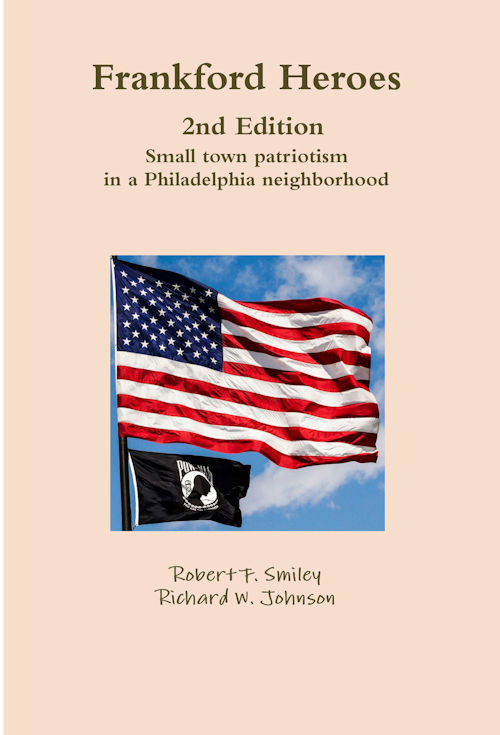Final Installment of Lyle (Corky) Larkin remembers:
Regrets
My only regret is not paying more attention while growing up and for taking so many of these adventures for granted at the time of their happening. I left Philadelphia in September of 1978, heading for warmer places. Many times during the course of my life, I fondly look back and recall the many good times I had in growing up in Philly. I consider myself extremely fortunate for spending my childhood in Frankford and for having all the experiences that the city had to offer. We had no drunks walking the streets, no shrewwives screaming, no bullies in school; but even in those days, we as kids were made aware that Philadelphia had some “bad neighborhoods” and those we stayed away from even as we became older. I‟m always proud to announce to people when they ask, that I‟m from Philly! That city really lives up to it‟s motto! “The City Of Brotherly Love” I try to make it a point to go back once a year for visits.
Each time I do, it brings back more fond memories. Most of all, I miss the friendliness of my old neighborhood. I also miss the lightning and thunderstorms of the summer. So take a moment and go back with me, ok? I’m talkin’ bout hide and go seek at dusk. Sittin’ on the porch, Hot bread and butter. The Good-Humor man, Red light, Green light. Chocolate milk, Lunch tickets, Penny candy in a white paper bag. Playin’ Pinball in the corner store. Hopscotch, butterscotch, double-dutch Jacks, kickball, dodgeball, Mother May I? Red Rover and Rolly Polly Hula Hoops and Sunflower Seeds, Jolly Ranchers, Banana Splits Wax Lips and Mustaches Running through the sprinkler The smell of the rain…. Wait;…… Watching’ Saturday morning cartoons. Some of my favorite morning cartoons were, Howdy Doody Fat Albert, The Road-Runner, The Three Stooges, Willy The Worm and Bugs Bunny, Or back further, listening to Superman on the radio Catchin’ lightening bugs in a jar, shootin empty cans with a sling shot. When around the corner seemed far away, and going downtown seemed like going somewhere really special. Bedtime, Climbing trees. An ice cream cone on a warm summer night Chocolate or vanilla or strawberry or maybe butter pecan. A lemon coke from the fountain at the corner drug store A million mosquito bites and sticky fingers, Sittin on the curb, Cops and Robbers, Cowboys and Indians, Jumpin down the steps, Jumpin on the bed. Pillow fights, runnin till you were out of breath Laughing so hard that your stomach and face hurt. Being so tired from playin’that you would fall asleep at the dinner table. Remember that? I ain’t finished just yet… Eating Kool-aid powder with sugar Remember when…When there were two types of sneakers for girls and boys (Keds & PF Flyers) and the only time you wore them at school, was for “gym. class” When it took five minutes for the TV to warm up, if you even had one. Ours had a big magnifying glass in front of it so it looks twice as big as it was. We also had a piece of colored plastic stuck to the screen, it was blue on top yellow in the middle and green on the bottom and that was our “Color TV” When nearly everyone’s mom was at home when the kids got there. When nobody owned a purebred dog When a quarter was a decent allowance, and another quarter a miracle. When milk went up one cent and everyone talked about it for weeks? When you’d reach into a muddy gutter for a penny. When girls neither dated nor kissed until late high school, if then. When your Mom wore nylons that came in two pieces. When all of your male teachers wore neckties and female teachers had their hair done, everyday When you got your windshield cleaned, oil checked and gas pumped, without asking, for free, every time. And, you didn’t pay for air. And, you got trading stamps to boot! When laundry detergent had free glasses, dishes or towels hidden inside the box. When any parent could discipline any kid, or feed him or use him to carry groceries, and nobody, not even the kid, thought a thing of it. When it was considered a great privilege to be taken out to dinner at a real restaurant with your parents. When they threatened to keep kids back a grade if they failed. and did! When being sent to the principal’s office was nothing compared to the fate that awaited a misbehaving student at home. Basically, we were in fear for our lives but it wasn’t because of drive-by shootings, drugs, gangs, etc. Our parents and grandparents were a much bigger threat! and some of us are still afraid of em!!! Didn’t that feel good.. just to go back and say, Yeah, I remember that! There’s nothing like the good old days! They were good then, and they’re good now when we think about them.




